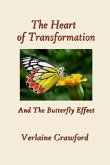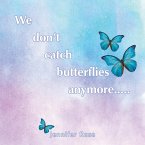H. T. Manogue
The Butterfly Ball
21,99 €
inkl. MwSt.
Versandfertig in 1-2 Wochen

11 °P sammeln
H. T. Manogue
The Butterfly Ball
- Broschiertes Buch
- Merkliste
- Auf die Merkliste
- Bewerten Bewerten
- Teilen
- Produkt teilen
- Produkterinnerung
- Produkterinnerung
The Butterfly Ball is a story of transformation, and Hal Manogue masterfully weaves events that bring about resolution to painful situations in one way or another. He shows the importance of our perception and how by the way we look at things, we create our heaven or hell right here and now. This story does not sugar-coat life. It is filled with many of the dilemmas that are faced, and shows how the way we handle them can support us in building meaningful lives or condemn us to a life lived in fear.
Andere Kunden interessierten sich auch für
![The Heart of Transformation: And the Butterfly Effect The Heart of Transformation: And the Butterfly Effect]() Verlaine CrawfordThe Heart of Transformation: And the Butterfly Effect10,99 €
Verlaine CrawfordThe Heart of Transformation: And the Butterfly Effect10,99 €![The Butterfly Bride The Butterfly Bride]() T. Mike WalkerThe Butterfly Bride16,99 €
T. Mike WalkerThe Butterfly Bride16,99 €![The Butterfly Fields The Butterfly Fields]() Carole Vickie PilcherThe Butterfly Fields15,99 €
Carole Vickie PilcherThe Butterfly Fields15,99 €![Life of A Human Butterfly Life of A Human Butterfly]() Patricia GoodwynLife of A Human Butterfly16,99 €
Patricia GoodwynLife of A Human Butterfly16,99 €![Butterfly Moments: Encouraging Encounters At An Inner-City High School Butterfly Moments: Encouraging Encounters At An Inner-City High School]() Caroline GreenButterfly Moments: Encouraging Encounters At An Inner-City High School16,99 €
Caroline GreenButterfly Moments: Encouraging Encounters At An Inner-City High School16,99 €![A Butterfly Born A Butterfly Born]() Velly AbrahamA Butterfly Born18,99 €
Velly AbrahamA Butterfly Born18,99 €![We don't catch butterflies anymore..... We don't catch butterflies anymore.....]() Jennifer RoseWe don't catch butterflies anymore.....23,99 €
Jennifer RoseWe don't catch butterflies anymore.....23,99 €-
-
-
The Butterfly Ball is a story of transformation, and Hal Manogue masterfully weaves events that bring about resolution to painful situations in one way or another. He shows the importance of our perception and how by the way we look at things, we create our heaven or hell right here and now. This story does not sugar-coat life. It is filled with many of the dilemmas that are faced, and shows how the way we handle them can support us in building meaningful lives or condemn us to a life lived in fear.
Produktdetails
- Produktdetails
- Verlag: shortsleeves
- Seitenzahl: 248
- Erscheinungstermin: 28. September 2012
- Englisch
- Abmessung: 229mm x 152mm x 15mm
- Gewicht: 408g
- ISBN-13: 9780977813056
- ISBN-10: 0977813053
- Artikelnr.: 36653990
- Verlag: shortsleeves
- Seitenzahl: 248
- Erscheinungstermin: 28. September 2012
- Englisch
- Abmessung: 229mm x 152mm x 15mm
- Gewicht: 408g
- ISBN-13: 9780977813056
- ISBN-10: 0977813053
- Artikelnr.: 36653990
A Poet's Journey There's no denying it. My physical personality was lost in one crazy badass netherworld of misremembering for the first forty-seven years of my life. My inner personality was getting body-slammed by my physical one while I was building my egocentric world. I like to say I was a religious, capitalistic slave, immersed in a vat of distorted values. And here's the thing: that is a realistic description of the physical image I created through years of business conditioning and knee-jerk personal choices. I was a hardheaded, egotistical college dropout with doctoral-level personality skills. My goal was to sell my way to fame and glory, one shoe at a time. I was a money-hungry young shoe salesman-a shoe salesman willing to do the low-class ego dance for an order. I had the capitalistic brazenness to move up the corporate shoe ladder. My capitalistic persona would always stretch reasonability to its outer limits. So when I failed a time or two or three, I blamed the system. But I rose from my self-created ashes and got objectively successful again by selling more than one shoe at a time. I was selling container loads of shoes at one time. And once I felt successful, I wanted more power and more recognition. When I bet it all with a blundering, alcohol-enriched mind and threw my fun-loving talents on the shoe wolves, expecting to become one, my narrow-minded focus sent me over the cliff of self-discovery. My physical personality was in free fall, and all my lifelines burned in a fire I made. My reality started to change, and I started to feel another presence within me. My four-dimensional personality guided me to the bottom, so I could internally heal my self-imposed wounds. Once I hit bottom, my physical personality drifted in a mysterious mixture of self-pity and irrelevance. But my four-dimensional personality came to the rescue. My four-dimensional personality took over when my mother passed in 1996. And that personality helped me understand the passing of my younger brother, Bob, and my dad, Howard, in 2013. I felt something special during these monumental losses. It felt like I was standing in a nonphysical stream of understanding, and I felt the pure energy in that understanding. My physical personality followed that stream when I began reading psychology and philosophy books. I found Rumi quotes in many of those books, so at forty-seven, I bought my first Rumi book. Rumi, the thirteenth-century Sufi mystic, is an inner-self shaker. I started to look at the nonphysical part of things because of Rumi. Then Confucius, Lao Tzu, Buddha, the German poet Rainer Maria Rilke, and the Englishman William Blake gave me their versions of inner personality expressions. Ralph Waldo Emerson, Ernest Holmes, James Allen, Jesus, Muhammad, and other soul-seekers through the ages all said the same thing. And they all used their inner personalities to say it. By the time I found Japan's Shinkichi Takahashi's work, I was on the edge of a nonphysical bridge. I realized that I'd been on that bridge all my physical life but had ignored being there. I'd always felt the presence of an agreeable being in my thoughts. But I rarely paid attention to that being until I read Ask and It Is Given as soon as it was published. Abraham, the author of the book, is a nonphysical energy personality who expresses commonsense thoughts about the nature of physical life. Then I hit the jackpot when I found the Seth Material. Jane Roberts, the poet and writer, brought the thoughts of nonphysical Seth into my world during my fifties. When Elias and Zurac came into my life in the first decade of the twenty-first century through the internet and a booth at Nashville's Galactic Expo, I realized that these nonphysical personalities' unfiltered messages were helping me forge an unfiltered path on this physical journey. What I've learned on this journey is that I am here to physically experience my thoughts, emotions, and perceptions. I kno







